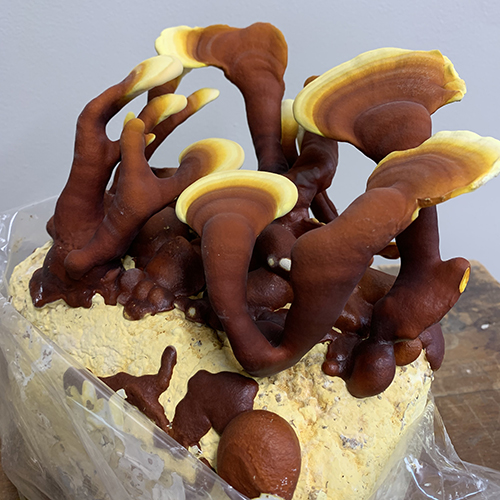
Table Top Farms are an incredible introduction into the world of fungi. They are available in several unique varieties (Shiitake, Oyster, Lion's Mane, Comb Tooth, Reishi, and Chestnut). All are fun and easy to grow. Reishi is a beautiful and potent medicinal mushroom. The fruit body is woody, variously shaped and colorful, taking many weeks to develop. This slow growth allows the cultivator to adjust airflow and light to achieve their desired shape. Follow the five steps below for setting up your Reishi Table Top Farm.
Setting Up Your Table Top Farm:
1. Preparation and Setup
Pull filter patch on bag forward allowing air to inflate the bag. Place the blocks in a warm location near a light source as the mushrooms will develop towards the light. Avoid 100% direct sunlight.
2. Maintaining and Monitoring
The top of the block will begin to form bumps on the top surface - these are the "pins" or beginnings of the Reishi mushrooms developing. The filter patch bag your block is in typically maintains the proper humidity around the developing mushrooms. Often times, condensation will naturally build up inside the bag and no additional watering is necessary during the pinning and antler stage (Figure 2). If there is still no condensation after 1 week, use a spray bottle to spritz water into the bag through the slit. Continue to monitor mushroom development and increase humidity by spritzing water into the bag if the mushrooms begin to shrivel, look dry, or get woody. Over the course of the first 1-4 weeks, the pins will elongate as they grow upward into the "antler" stage (Figure 3). These antlers contain all the medicinal benefits of the fully conched mushroom and can be harvested at this stage. If left to grow, the antlers will continue to grow upwards as tall as 10˝ or more until they are restricted by the bag.
Fun Fact: Reishi mushrooms are phototrophic, meaning they grow towards the light similar to plant seedlings.
3. Mushroom cap development and conch formation
Getting your Reishi antlers to conch (Figure 4), or form a mature mushroom cap, can be challenging. It requires more light and increased air flow while protecting the mushrooms from drying out. To encourage conching, cut off the entire top of the bag, just under the seal when the antlers are 3-6˝ tall. To maintain humidity poke four wooden skewers into the block and drape the humidity tent over the farm. Increase overhead lighting and maintain humidity by diligently spraying the farm with a plant mister as needed. If the mushrooms begin to shrivel, look dry, or get woody, increase the humidity.
4. Harvesting and storing mushrooms
Reishi can be harvested at any growth stage by cutting them off at the base with a sharp pair of scissors. Conched Reishi mushrooms release a very high spore load - it will look like rust colored dust. Ideally, you should harvest the mushrooms before or just as this begins to happen. Reishi blocks fruit only once, so consider adding your block to the compost pile after harvesting.
Fresh Reishi mushrooms can be stored in the refrigerator for up to 4 weeks. A breathable container is ideal for reducing condensation and excessive wetness that will reduce mushroom shelf life. Alternatively, Reishi can be dried and stored for many months.
5. Teas and tinctures with your harvest
Check out the Field and Forest Products website for details on preparing tea and tincture.